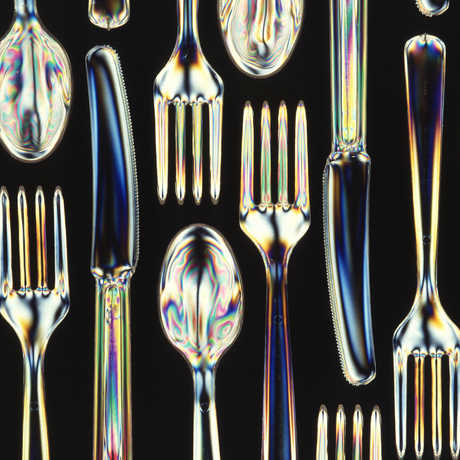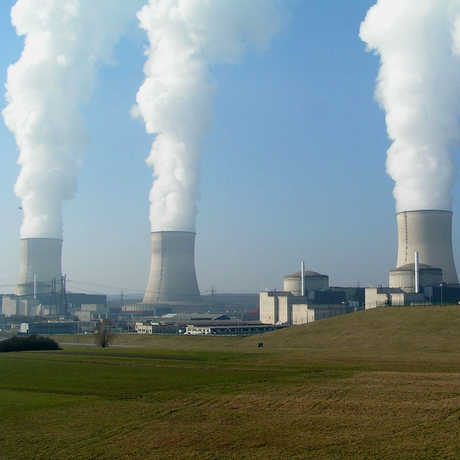What is the difference between synthetic and natural materials? How are synthetic materials made?
About This Video
Grade level: 6-10
Length: <4 minutes
Next Generation Science Standards: PS1.A, PS1.B, ESS3.C, ETS1.B
Video Discussion Questions:
- How is a synthetic material different from a natural one?
- What are some examples of synthetic materials?
- Where do the raw materials for making synthetic materials come from?
- Are synthetic materials good for the environment? Bad for the environment?
- Do synthetic materials benefit society? Why or why not?
Polymer Pursuits
Below you'll find activities related to synthetic materials to use in your classroom:
Biopolymers, Inc.

Plastic is durable and long-lasting, making it useful for packaging things like food, but not so good for the environment. Plastic in landfills can take hundreds of years to degrade, and plastic debris in the ocean is a threat to marine life.
Traditional plastic is made from petroleum, but there is a movement now to make plastics from more renewable—and in some cases biodegradable—organic sources, like vegetable fats. These 'bioplastics,' or biopolymers, can come in various forms with various physical properties. Knowing what kind of biopolymer would work best for a particular use is a creative design challenge!
Carrying Out Investigations and Designing Solutions
Present students with the following scenario: You have just started your own biopolymer company. The purpose of your company is to design and engineer plastic-like materials that are more environmentally-friendly than traditional petroleum-based plastics.
Part 1, Materials Testing: How does changing the formula of a biopolymer change its physical characteristics?
In the first part of this design challenge, students will create various biopolymer materials using different combinations of starches with glycerine, a plasticizer. The goal of this activity is to, as a class, produce a variety of different kinds of biopolymers with differing physical properties. Students should work in groups of 3-4.
Part 2, Application: Which biopolymer formula would be best suited for your company's product?
In the second part of this design challenge, students will use the data they collected from Part 1 to design a biopolymer product line for their company. Students must decide what biopolymer physical properties (and thus formulas) are desirable for their particular product and why.
Teacher's Guide for Part 1 & Part 2
Student Worksheets for Part 1 & Part 2
Photo credit: USDA
This lesson is based on a module created in collaboration between The Teaching Channel and Boeing: Polymers for the Planet.
Comparing Environmental Footprints: Natural vs. Synthetic Fibers

Some synthetic materials like polyester fabric are not great for the environment in that they can take a long time to degrade in landfills after they are thrown away. But what is the environmental impact of producing these synthetics, compared to more natural materials?
Teacher Prep
The figures in this activity come from the Ecological Footprint and Water Analysis of Cotton, Hemp, and Polyester report by Cherrett et al. In this activity, students will be learning about ecological footprints. The WWF defines 'ecological footprint' as the impact of human activities measured in terms of the area of biologically productive land and water required (often reported in global hectares) to produce the goods consumed and to assimilate the wastes generated. More simply, it is the amount of the environment necessary to produce the goods and services necessary to support a particular lifestyle.
Analyzing and Interpreting Data Activity
1. Write the following Focus Question on the board: How does the environmental footprint of producing natural fibers, like cotton, compare to the environmental footprint of producing synthetic fibers, like polyester?
2. Review the concept of a 'supply chain' with your students. See Visual 1 from this lesson by the Council for Economic Education.
3. As a class, think about how cotton and polyester clothes are made. What are the raw materials? Where do they come from? How are they transformed into clothing? What resources are needed for this transformation (e.g. land, water, energy, etc.)? Make a list of brainstormed processes and resources on the board.
4. Have students write in their science notebooks whether they think cotton or polyester is more environmentally-friendly to produce, and why.
5. Hand out a set of Ecological Footprint Figures to each pair of students. Each student should individually spend about 3-5 minutes analyzing each of the Figures and writing down observations in their notebooks.
Here are some questions you can write on the board to help your students analyze and interpret the information in the Figures:
- What do the bars on the graph represent? What information are they telling you? What do the different colors on the graph represent?
- What is the variable on the y-axis? What information is on the x-axis?
- What are some observations you can make from the graph? What are some interpretations you can make? What is the difference between an observation and an interpretation?
6. With their partner, students should spend about 10 minutes discussing what they learned from the Figures and deciding together what their answer to the Focus Question is and why.
7. Ask students to share their answers to the Focus Question. Then, hand out an Overall Ecological Footprint Figure to each pair and lead a class discussion on the environmental footprints of synthetic vs. natural materials.
- What do you notice/observe about this figure?
- Why do you think the overall Ecological Footprints of these fibers are expressed in global hectares?
- What other factors are considered in the overall ecological footprint other than carbon emissions and energy requirements?
- Which fibers have a smaller overall ecological footprint? Why do you think this is?
- How does the fiber production compare to the crop cultivation for various fibers in terms of their environmental footprint?
- Are there any fibers that had low CO2 emissions or energy requirements but large ecological footprints?
Extension: Hand out copies of the figures on page 17 of the report, and have your students explore in more detail the ecological footprint of each step involved in the production of cotton and hemp (the supply chains).
Connections to the Next Generation Science Standards
While this video doesn't necessarily cover the following standards in depth, it is a compelling resource you can use to supplement your curriculum that does.
Disciplinary Core Ideas (Grades 6-8)
PS1.A: Structures and Properties of Matter
PS1.B: Chemical Reactions
ESS3.C: Human Impacts on Earth Systems
ETS1.B: Developing Possible Solutions
Crosscutting Concepts (Grades 6-8)
Structure and Function
Energy and Matter: Flows, Cycles, and Conservation
Exploring Energy: About This Unit
Energy is an important part of our everyday lives. We use energy to cook, get around, and send emails. In this unit, we'll explore the issues associated with fossil fuels and how people are coming up with innovative sustainable energy alternatives for a brighter future.
Browse All Materials:
- Video: What's the Deal With Fossil Fuels?
- Video: Buses and Biofuels: Sustainable Transportation
- Video: Renewable Energy: Clean Tech Solutions
- Video: Renewable Energy: Powered by Poop
- Video: Nuclear Energy: Is Fission the Future?
- Activity: Nuclear Energy: What's Your Reaction?
- Video: Your Digital Footprint: Data and Energy Use
- Supplemental Video: The Chemistry of Clothes [you are here]
- Supplemental Video: How To Measure a Changing Climate
- Supplemental Video: The Climate is Changing but How's the Weather?
Additional Resources
Turning food waste into tires
Learn how researchers at The Ohio State University are experimenting with replacing petroleum-based filler in the rubber used to make tires with eggshells and tomato peels.
Science News for Students: What are polymers?
Learn more about polymers and their properties and what impacts they can have on the environment over time.
